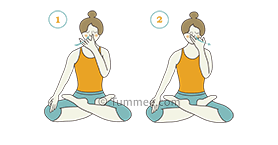
Alternate Nostril Breathing (Nadi Shodhana) >> in het Engels eerst, mogelijk ga ik het nog vertalen in de toekomst 🙂
This simple, yet most powerful technique, is a pranayam that is easy to do, yet can take you through all the stages of your yoga practice.
How to do Alternate Nostril Breathing:
In this pranayam, the breath is always relaxed, deep and full.
Have the left hand in Gyan Mudra.
Use the thumb of the right hand to close the right nostril, and the index
finger or ring finger of the right hand to close the left nostril.
Close the right nostril and gently and fully inhale through the left nostril.
Then close the left nostril and exhale through the right nostril.
Then inhale through the right nostril.
Close the right nostril and exhale through the left nostril.
Continue repeating, alternating nostrils after each inhalation.
Voordelen Alternate Nostril Breathing:
Creates whole brain functioning by balancing the right and left
hemispheres.
Is both integrating and grounding.
Purifies the ida and pingala nadis, gently.
Creates a deep sense of well-being and harmony on the physical, mental,
and emotional levels.
Can help with headaches, migraines, and other stress-related symptoms.
Inhale left, exhale right: Helps to make you calm and integrates
unwanted negative emotions and stress. Excellent by itself before bed.
Inhale right, exhale left: Gives clarity, and positive mood. Helps us to focus
on what is important.
Nadi Cleansing (“U” Breathing): A powerful, classical technique which utilizes
Nadi Sodhan as well as Breath Ratios.
Breath Ratios
When breathing in different breath ratios, we are changing the amount of time
that we take to inhale, hold, and exhale the breath. In general, we breathe in
an equal breath ratio—equal inhale, equal exhale.
Consciously using different breath ratios can yield varied effects.
By emphasizing inhaling, the sympathetic part of the autonomic nervous system
boosts the heart rate and blood pressure, boosts alertness and stimulates us.
By emphasizing exhaling, the parasympathetic nervous system slows the
heartbeat and relaxes the circulation, nerves, and digestive system. It relaxes us
and promotes elimination, both physically and emotionally.
You can use mantra to measure the ratios. For example:
1:4:2 (Inhale I, hold 4, exhale 2). This is used in the Nadi Cleansing pranayam. It is
powerfully purifying and cleansing.
Left Right Nostril Breathing
Through the simple mechanism of closing or opening one of the nostrils, the yogi
has a wide array of techniques to control his moods and energies. The quality of
Prana processed through the two nostrils differs correspondingly with the
qualities associated with the two sides of the brain. The nerves going out from
the two brain hemispheres cross at the level of the eyebrows. The left
hemisphere is connected to the right side of the body and right nostril, and the
right hemisphere to the left side of the body and left nostril.
We breathe predominantly through one nostril or the other at any given time.
The dominant nostril alternates rhythmically every 90 to 150 minutes. The length
of the cycle reflects universal rhythms, individual temperament, and the
personal state of mental and physical balance. The rhythm itself is mediated
mainly through structures in the hypothalamus and pituitary, though other areas
in the brain are also involved.
You may use the technique of inhaling and exhaling exclusively through either
the left or right nostril in order to benefit from the quality associated with that
nostril. For instance, breathe exclusively through the left nostril to deal with
compulsive eating habits.
Breathing through the left nostril is associated with:
Ida, the nadi which ends at the left nostril
Apana, the cleansing energy
The Moon energy—cooling, receptive
Calmness
Empathy
Sensitivity
Synthesis
Breathing through the right nostril is associated with:
Pingala, the nadi ending at the right nostril
Prana, the nurturing energy
The Sun energy—warming, projective
Vigor
Concentration
Alertness
Readiness-for-action
Will power
Inhale Sat. Exhale Naam.
© 2003 The Teachings of Yogi Bhajan, KRI International Teacher Training Manual
